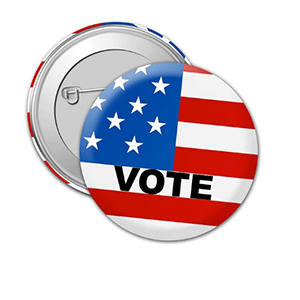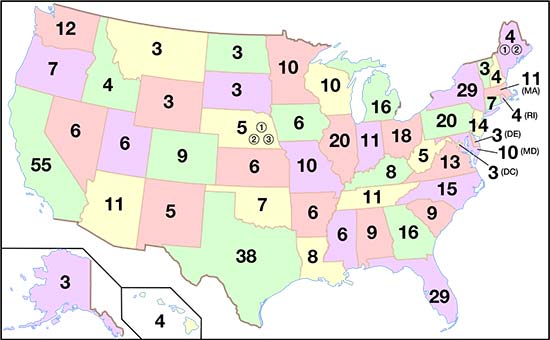 American democracy calls for "a government of the people, by the people, for the people," as Abraham Lincoln famously stated in his Gettysburg Address on Nov. 18, 1863.
American democracy calls for "a government of the people, by the people, for the people," as Abraham Lincoln famously stated in his Gettysburg Address on Nov. 18, 1863.
Yet the office of the president is not technically elected by the people...
You see, the United States uses an Electoral College system -- instead of the popular vote -- to decide who wins the Oval Office every four years.
That's why one of the most common questions asked during an election is, "What is the Electoral College?"
We're here to answer that question for you.
Exactly What Is the Electoral College?
The Electoral College is a group of people who ultimately elect the president and vice president.
The college consists of 538 electors who are chosen to vote on behalf of their state. The number "538" may seem random, but it is designed to equal our number of congressional members (435 representatives, 100 senators, plus three more from the District of Columbia).
These 538 electors meet on the first Monday after the second Wednesday in December to cast their votes for president and vice president.
Here's the key: Electors are encouraged - but not required - to cast their votes based off of the popular vote in their state.
Usually each elector has a party in mind before they are informed of the popular vote...
How Are Electoral College Members Chosen?
A state's political parties choose potential electors at their state's party conventions or by vote via the party's central committee, so it helps to have long-standing service and dedication to your party.
Up Next: Get the Best Investing Research Today to Grow Your Money
In terms of other credentials, the U.S. Constitution makes no mention of the qualifications to become a member of the Electoral College, but it does state that they cannot be:
- A member of U.S. Congress
- A high-ranking U.S. official
- Someone who has "engaged in insurrection or rebellion" against the United States
As long as you do not fall into any of the above categories, you are technically eligible to become an elector.
Now let's take a look at how many electors represent each state...
How Are the State Votes Allocated?
Each state receives two votes, or elector spots, automatically. Then, the states receive additional votes according to population count. Originally, this was a problem because the District of Columbia was not recognized as a state and therefore received zero Electoral College votes. In 1961, the 23rd Amendment was passed, which gave D.C. the automatic two votes, plus one more -- the same as the least-populated state in America, Wyoming.
Every 10 years, in a process called reappointment, the number of electors for each state is reallocated according to current population. Each state may gain or lose votes during this process.
Trending: Here's What Single-Payer Healthcare Would Do to Your Taxes
Here's the electoral map by state for 2016. The numbers represent how many electoral votes the individual states receive:

You'll note that California, Texas, Florida, and New York have the most electoral votes out of all the states. California (55) is at the top; it has voted "Blue" since the 1992 election. On the other hand, Texas (38), with the second most electoral votes, has voted "Red" since the 1980 election. While Florida (29) and New York (29) are tied for third most electoral votes, Florida is especially interesting because it historically has been considered a "swing state"...
A swing state is a state where votes are fairly evenly split between the two parties. In one election cycle, they may vote Republican, and in the next, Democrat. Typically if a candidate fails to win over the majority of swing states, they'll lose the election. For instance, Florida has cast votes for the winning presidential candidate 75% of the time between 1900 and 2012.
Arguments for the Electoral College vs. Popular Vote
Every four years, the Electoral College is put back into the spotlight as being an outdated and corrupt system. In a 2013 survey conducted by Gallup, 63% of Americans would vote "for" doing away with the Electoral College.
But what most Americans probably don't realize are the negative consequences of reverting back to solely the popular vote...
For example, mainly liberal states like California, New York, and Maryland would overpower votes from many other states because of population. In other words, the needs and wants of the people in less-populated states would be ignored during elections.
To the same point, the Electoral College helps to draw attention from presidential candidates to each of the states. If the system were reversed back to solely the popular vote, states with low population rates would be less attractive to candidates. For example, Wyoming, a state with a population of less than 600,000, would be less likely to get any attention from a candidate compared to Pennsylvania, a state with over 12 million residents.
Why does this matter?
Because the needs of the people in Wyoming deserve just as much consideration from the future POTUS as the needs of the people in Pennsylvania.
Without the Electoral College system, votes from states that have low population rates (North and South Dakota, Alaska, etc.) would essentially be wiped out by states like California, New York, and Texas.
Supporters of the Electoral College also argue that the system promotes a two-party structure, which allows the country to maintain continuity and stability. [Editor's Note: With a majority of voters saying they're unhappy with the two major-party candidates, America may be ripe to consider a third choice...]
But 37% of Americans still think the system is unfair -- and they have an extremely good reason why...
Arguments Against Electoral College vs. Popular Vote
The main problem with the Electoral College is that while electors are supposed to vote according to the outcome in their state, they are not required to do so.
[mmpazkzone name="in-story" network="9794" site="307044" id="137008" type="4"]
And in fact, since the founding of the Electoral College, individual electors have voted against the person the citizens voted for over 80 times.
That's why the opposition to the Electoral College system note this as being the main reason why citizens do not vote at all: It's a system that promotes apathy -- not what you want in a democracy that relies on election to achieve the best representatives for the people.
Aside from that, there are also two lesser problems with the Electoral College. First, it's somewhat outdated. It was developed because in the 1800s, casting a vote required you to write your decision on a ballot, give it to a good lad on horseback, and wish him safe travels to Washington. Since then, things have changed...
The system allocates votes to each state, but doesn't account for the citizens who don't live in a recognized state. For example, the people in U.S. territories like Guam, Puerto Rico, and the Virgin Islands do not have electoral votes. That's 4.4 million people that are directly affected by the election but don't get a say in the outcome.
And second, because of the way electoral votes are allocated among the states, some states receive more (or less) votes than they really should. Each state automatically receives two votes, regardless of population size. So a state like Rhode Island, which should only have two votes based on population, gets four votes. This causes a state like Ohio, which should have 20, to only have 18.
Next Up: The real reason Congress gets nothing done isn't partisan gridlock. It's that the primary duty of our elected representatives is no longer making laws - it's this...
Have friends and family also wondering "What is the Electoral College"? Please share our content with them on Twitter @moneymorning or Facebook.
You may also like...
It's Time to Change a System That Cheats Third-Party Candidates
How Both Trump and Clinton Could Fail to Win the 2016 Presidential Election


